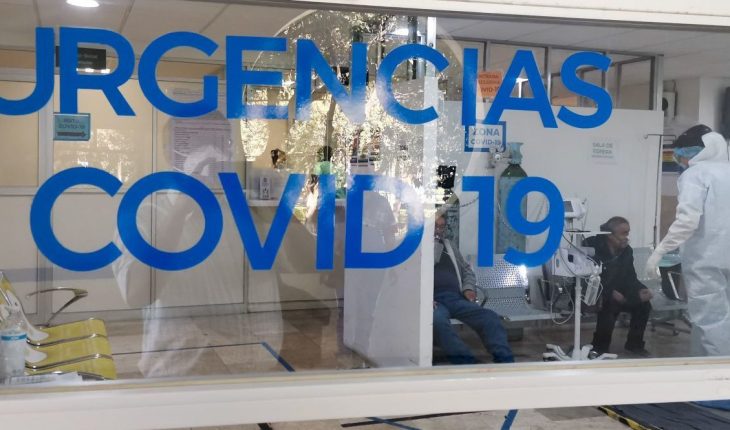This January 2nd, the government of Mexico City reported, through the Daily Report on COVID-19 that it is issued every day, that in hospitals in the capital of the country there were 6 thousand 225 people in hospital, an availability of general hospitalization beds of 21.3% and 19.9% in those reserved for those who are critically ill and require intubation.
In a single month, from December 1, when 3,839 people were registered hospitalized, as of January 1, when 6,155 patients were reported, the number of people admitted to the capital’s health institutions grew by 62%. Those were still joined, from the first day of the year to the second day, by 70 other people.
Despite this, hospital occupation has shown less pressure in recent days. On December 23, the CDMX government reported that there was only 9% availability in general hospitalization beds and 14.1% in fan beds. By 2 January, these percentages managed to expand.
Read: Mexico surpasses 127,000 COVID deaths and records more than 5,000 new cases
But this is due to the increase in the number of beds that the various institutions have been working on, to have more infrastructure for those affected with COVID-19, and not because there are fewer people entering hospitals.
On 28 December, the local government reported that hospital capacity in the capital had increased by 37% in general beds and 26% in intubation beds. The head of government, Claudia Sheinbaum, highlighted that some 7,377 general beds were planned to arrive at the end of December in all COVID-19 public hospitals in the capital and a thousand 918 intensive care beds.
“In the case of fan beds we are growing to a thousand 918 by December 31, with a very important effort by all health institutions, and this represents an increase, in a month, of 26% of capacity in public hospitals; i.e. it’s almost 500 extra intensive care beds.” The head of government stressed that this growth is a very important effort because it is not only having more beds, but oxygen, facilities and medical equipment.
Sheinbaum explained that according to projections of the Epidemiological Model of the Metropolitan Zone of the Valley of Mexico (ZMVM) it is estimated that in the last days of December and the first days of January a hospital occupation of 9 thousand 512 beds could be recorded on the highest stage and on the middle stage, 8 thousand 907.
“Between the State of Mexico and Mexico City, in all public health institutions, we have 10 thousand 457 beds, some of them are still being converted, and the maximum occupancy expected to reach (throughout the area) is 9 thousand 512,” stressed the capitalist.
The federal health authorities and those of Mexico City estimate that the effects of having declared, on December 18 last, red at the COVID-19 Risk Traffic Light for the capital and the State of Mexico, and closing all non-essential activities, will begin to be seen from this January 3.
Read: CDMX exceeds 21,000 COVID deaths; hospitals have only 24% availability
The chains of contagion, they have explained, do not stop overnight, so cases do not begin to fall until days after restrictions that impact people’s mobility. It will then be from this Monday onwards that cases should start to drop.
How much they descend will depend on how much mobility has declined and the recommendations for not partying for decembrian festivities have been taken. During Christmas and New Year, in Mexico City there were 593 complaints for holidays, registered by the Center of Command, Control, Computation, Communications and Citizen Contact of the capital, the C5.
The colonies where most festivities were recorded this December 31st were: Carmen Serdán, in Coyoacán; Balbuena Garden, in Venustiano Carranza; I located the Caballito and Santa Rosa, in Alvaro Obregón and Carlos Zapata Vela, in Iztacalco.
Explosive rise
December started in the capital with 3,839 people hospitalized, a general occupancy bed availability of 40.6% and 55.6% in fan beds. By December 10, people admitted to health institutions in Mexico City were already 4,382, availability in general occupancy beds was reduced by 31.5% and beds for critically ill patients requiring ventilatory support to 51%.
Another ten days later, on December 20, there were already 5,089 patients in hospitals in the capital, the availability of general occupancy beds fell to 19.9% and in fan-cooled beds to 23.7%.
The 30de December the people hospitalized in the CDMX were already 5 thousand 961 and availability in general hospitalization beds had achieved a respite, reaching 24.1% and at the same percentage in terms of fan beds, having had a risky drop to only 9% occupancy in general beds on 23 December and 14.1 in fan beds.
The red light in the capital and the State of Mexico will remain so until January 10, when it will be evaluated whether this extends, according to the number of cases and hospitalizations, or whether it is already possible to lift some of the restrictions for all non-essential activities.
What we do at Animal Politics requires professional journalists, teamwork, dialogue with readers and something very important: independence. You can help us keep going. Be part of the team.
Subscribe to Animal Politics, receive benefits and support free journalism.#YoSoyAnimal
translated from Spanish: COVID hospitalizations continue to grow in CDMX, up 62% in a month
January 4, 2021 |





